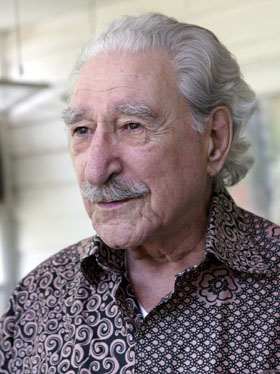Michel Chartrand facts for kids
Quick facts for kids
Michel Chartrand
|
|
|---|---|

Chartrand in 2007
|
|
| Born | 20 December 1916 |
| Died | 12 April 2010 (aged 93) Montérégie, Quebec, Canada
|
| Occupation | Trade unionist |
| Spouse(s) |
Simonne Monet-Chartrand
(m. 1942) |
| Children | Alain Chartrand |
Michel Chartrand (born December 20, 1916 – died April 12, 2010) was an important Canadian trade union leader from Quebec. He spent his life fighting for the rights of workers and for a fairer society. He was married to Simonne Monet-Chartrand, who was also a famous writer and activist for women's rights and unions.
Contents
Early Life and Union Work
Michel Chartrand was born in Outremont, a neighborhood in Montreal. He went to school at Collège Jean-de-Brébeuf and collège Sainte-Thérèse. For a short time, he even trained to be a Trappist monk. He later worked in printing and became very interested in helping workers.
In the 1940s, Chartrand started getting involved in union activities. This was a time when many workers faced tough conditions. He took part in big strike actions, which are when workers stop working to demand better pay or conditions. Some of these famous strikes included the Asbestos strike in 1949, the Louiseville Strike in 1952, and the Murdochville strike in 1957. These events helped shape his strong belief in workers' rights.
Fighting for Workers' Rights
In 1968, Michel Chartrand became the president of the Montreal central council of the Confédération des syndicats nationaux (CSN). This was a major union group in Quebec. He held this important position until 1978. During his time as president, he worked hard to improve conditions for many workers.
He was a strong supporter of syndicalism, which means people working together in unions to have a stronger voice. He believed that workers should have more power and control over their jobs and lives. In 1970, during a difficult time known as the October crisis, he was put in jail for four months.
In the 1980s, Chartrand focused on helping workers who had been injured on the job. He created a group called the Fondation pour l’aide aux travailleuses et travailleurs accidentés (FATA) in 1984. This foundation helped injured workers get the support they needed. He continued to share his ideas about fair treatment and workers' rights in the media throughout his life.
Important Beliefs and Actions
Michel Chartrand believed in socialism, which is an idea about society where resources are shared more fairly among everyone. He was also a strong critic of capitalism, an economic system where businesses are mostly owned by private individuals. He thought that capitalism often led to unfairness for workers.
He was a leading figure in the union movement in Quebec. He supported the idea of Quebec independence, meaning Quebec becoming its own country. He also supported the political party Québec solidaire, which promotes progressive values.
Against Conscription
During World War II, the Canadian government decided to hold a vote on conscription. This meant forcing people to join the army. Michel Chartrand was strongly against this idea. He joined a movement called the Bloc populaire canadien to campaign against conscription.
He was married to Simonne Monet in 1942. By the time conscription was put in place in 1944, he was already a father of three children. He believed that people should not be forced to fight in wars if they did not want to.
Trying for Political Office
Michel Chartrand tried to get elected to political office several times. He ran as a candidate for different parties that shared his ideas about social justice and workers' rights. For example, he ran for the Bloc Populaire in 1945 and for the Cooperative Commonwealth Federation (CCF) in the 1950s. The CCF was a party that believed in social democracy, which aims to create a fairer society through democratic means.
Even though he didn't win these elections, he continued to be a powerful voice for change. His union duties often involved leading important strikes, and many saw him as a future leader of the workers' movement.
Working for Peace and Change
In 1960, the Catholic Workers Confederation of Canada changed its name to the Confédération des syndicats nationaux (CSN), which is the union group Chartrand later led. He was also very active in the peace movement. He took part in demonstrations against nuclear weapons and other causes that promoted peace around the world.
He was interested in the communist revolution in Cuba and its leader Fidel Castro. In 1963, he visited Cuba for a month. When he returned, he described Cuba as "a paradise" and suggested that Quebec could learn from its example. He then helped start the Parti socialiste du Québec (Socialist Party of Quebec) and began supporting the idea of Quebec becoming independent.
In Film
Michel Chartrand and his wife, Simonne Monet, were so important that their lives were made into a television mini-series called Chartrand et Simonne. Michel Chartrand was also the subject of a 1991 documentary film called Un homme de parole (A Man of His Word). He even had a small acting role in a 1970 comedy film called Two Women in Gold.
Death
Michel Chartrand passed away on April 12, 2010, from kidney cancer. To honor his memory and his contributions, a park in Longueuil was renamed Parc Michel-Chartrand in June 2010.
Images for kids


